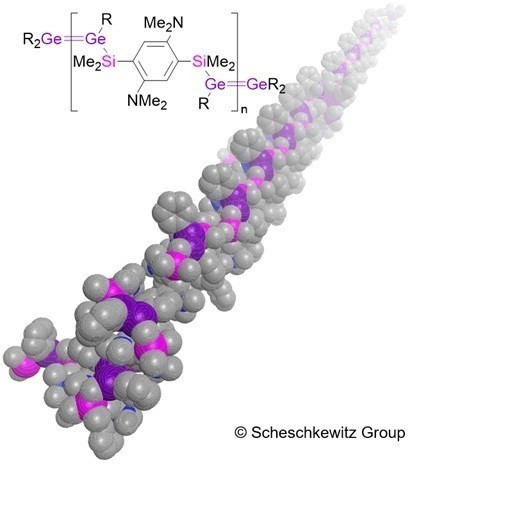Materials & Surfaces
Various research groups of chemistry department focus on projects in the field of new materials with switchable properties. The main focus is on interface-dominated materials and polymers.

The efficient and fast switching of soft materials by an external stimulus for themodification of macroscopic properties is achieved by so-called intelligent ("smart") polymers. These react quickly and reversibly to changes in temperature, pH value, light, redox reagents, mechanical stress and external electrical or magnetic fields. The synthesis and characterization of these materials is the focus of the Gallei group. Besides the design of polymers, the development of functional monomer building blocks plays an important role in order to generate completely new materials with hitherto unexplored application profiles.

The Scheschkewitz group synthesizes novel Polymers on the basis of unsaturated building blocks of the heavier main group elements and develops and applies molecular precursors for the generation of thin films from the gas phase by chemical vapor and atomic layer deposition techniques. Alternatively, the Munz and Gallei research groups are investigating novel strategies for the post-functionalization of existing polymer systems. In the research group del Campo hydrogels with selective reaction to light of different wavelengths are developed. These dynamic materials encode several functionalities in a latent state, which can be activated during use if required. The group uses them as instructive biomaterials for cell encapsulation and tissue reconstruction.

In the Kickelbick group, highly transparent polymer materials based on siloxanes are developed, which are for example used in LED technology. The Munz group develops optoelectronic devices in the border area from molecule to material, which can be embedded in such matrices.
Another research focus is the combination of inorganic and organic components for the synthesis of hybrid materials and nanocomposites. So-called elastomeric opal films, such as those developed by the Gallei group, show all rainbow colors under mechanical stress and depending on the viewing angle, and the reflection colors can be selectively switched.
The Kickelbick group investigates switchable, intelligent materials using polymers as matrix materials. By incorporating chemical functions, such materials can build up a potential for self-healing, which significantly prolongs the lifetime of the material and thus significantly contributes to a sustainable product design. The Kraus group, located at the Leibnitz Institute for New Materials (INM), is also investigating hybrid materials. The bio-inspired material structures help to (re)find sustainable materials. The research group is investigating how hybrid materials can be structured in a targeted way by self-arrangement and self-organization. This combination results in different, sometimes seemingly contradictory material properties for applications in electronics, optics and sensor technology.
The del Campo group, also located at the INM-Leibniz Institute for New Materials, synthesizes biohybrid materials with embedded living cells as active components of synthetic matrices with the aim to equip non-living matter with lifelike capabilities. Such living hybrids are studied for medical applications, for example as self-renewing, drug-eluting units for the personalized treatment of chronic diseases. The campus of Saarland University houses the Leibniz Science Campus "Living Therapeutic Materials", which is dedicated to this topic.

In modern materials, nanoparticles serve as building blocks for a wide variety of functional materials. The production of these basic building blocks often requires very special synthesis routes and special strategies for their surface modification, which are worked out in the research groups Kickelbick and Kraus.
New synthesis concepts are also applied, such as the production of materials by mechanochemical approaches or the continuous synthesis of nanoparticles.
- Prof. Dr. Aránzazu del Campo
Materials Synthesis and Materials Development and Leibniz-Institute for New Materials - Prof. Dr. Markus Gallei
Polymer Chemistry - Prof. Dr. Guido Kickelbick
Inorganic Solid State Chemistry - Prof. Dr. Tobias Kraus
Colloid and interface chemistry and Leibniz-Institute for New Materials - Prof. Dr. Dominik Munz
Coordination Chemistry - Prof. Dr. David Scheschkewitz
General and Inorganic Chemistry
